JAJSFM9A June 2018 – July 2018 TMS320F28035-EP
PRODUCTION DATA.
- 1デバイスの概要
- 2改訂履歴
- 3Terminal Configuration and Functions
-
4Specifications
- 4.1 Absolute Maximum Ratings
- 4.2 ESD Ratings
- 4.3 Power-On Hours (POH) Limits
- 4.4 Recommended Operating Conditions
- 4.5 Power Consumption Summary
- 4.6 Electrical Characteristics
- 4.7 Thermal Resistance Characteristics
- 4.8 Thermal Design Considerations
- 4.9 Emulator Connection Without Signal Buffering for the MCU
- 4.10 Parameter Information
- 4.11 Test Load Circuit
- 4.12 Power Sequencing
- 4.13 Clock Specifications
- 4.14 Flash Timing
-
5Detailed Description
- 5.1
Overview
- 5.1.1 CPU
- 5.1.2 Control Law Accelerator (CLA)
- 5.1.3 Memory Bus (Harvard Bus Architecture)
- 5.1.4 Peripheral Bus
- 5.1.5 Real-Time JTAG and Analysis
- 5.1.6 Flash
- 5.1.7 M0, M1 SARAMs
- 5.1.8 L0 SARAM, and L1, L2, and L3 DPSARAMs
- 5.1.9 Boot ROM
- 5.1.10 Security
- 5.1.11 Peripheral Interrupt Expansion (PIE) Block
- 5.1.12 External Interrupts (XINT1–XINT3)
- 5.1.13 Internal Zero Pin Oscillators, Oscillator, and PLL
- 5.1.14 Watchdog
- 5.1.15 Peripheral Clocking
- 5.1.16 Low-power Modes
- 5.1.17 Peripheral Frames 0, 1, 2, 3 (PFn)
- 5.1.18 General-Purpose Input/Output (GPIO) Multiplexer
- 5.1.19 32-Bit CPU-Timers (0, 1, 2)
- 5.1.20 Control Peripherals
- 5.1.21 Serial Port Peripherals
- 5.2 Memory Maps
- 5.3 Register Maps
- 5.4 Device Emulation Registers
- 5.5 VREG/BOR/POR
- 5.6 System Control
- 5.7 Low-Power Modes Block
- 5.8 Interrupts
- 5.9
Peripherals
- 5.9.1 Control Law Accelerator (CLA) Overview
- 5.9.2 Analog Block
- 5.9.3 Detailed Descriptions
- 5.9.4 Serial Peripheral Interface (SPI) Module
- 5.9.5 Serial Communications Interface (SCI) Module
- 5.9.6 Local Interconnect Network (LIN)
- 5.9.7 Enhanced Controller Area Network (eCAN) Module
- 5.9.8 Inter-Integrated Circuit (I2C)
- 5.9.9 Enhanced PWM Modules (ePWM1/2/3/4/5/6/7)
- 5.9.10 High-Resolution PWM (HRPWM)
- 5.9.11 Enhanced Capture Module (eCAP1)
- 5.9.12 High-Resolution Capture (HRCAP) Module
- 5.9.13 Enhanced Quadrature Encoder Pulse (eQEP)
- 5.9.14 JTAG Port
- 5.9.15 General-Purpose Input/Output (GPIO) MUX
- 5.1
Overview
- 6Applications, Implementation, and Layout
- 7デバイスおよびドキュメントのサポート
- 8メカニカル、パッケージ、および注文情報
5.9.11 Enhanced Capture Module (eCAP1)
The device contains an enhanced capture (eCAP) module. Figure 5-38 shows a functional block diagram of a module.
 Figure 5-38 eCAP Functional Block Diagram
Figure 5-38 eCAP Functional Block Diagram The eCAP module is clocked at the SYSCLKOUT rate.
The clock enable bits (ECAP1 ENCLK) in the PCLKCR1 register turn off the eCAP module individually (for low-power operation). Upon reset, ECAP1ENCLK is set to low, indicating that the peripheral clock is off.
Table 5-52 eCAP Control and Status Registers
| NAME | eCAP1 | SIZE (x16) | EALLOW PROTECTED | DESCRIPTION |
|---|---|---|---|---|
| TSCTR | 0x6A00 | 2 | Time-Stamp Counter | |
| CTRPHS | 0x6A02 | 2 | Counter Phase Offset Value Register | |
| CAP1 | 0x6A04 | 2 | Capture 1 Register | |
| CAP2 | 0x6A06 | 2 | Capture 2 Register | |
| CAP3 | 0x6A08 | 2 | Capture 3 Register | |
| CAP4 | 0x6A0A | 2 | Capture 4 Register | |
| Reserved | 0x6A0C to 0x6A12 | 8 | Reserved | |
| ECCTL1 | 0x6A14 | 1 | Capture Control Register 1 | |
| ECCTL2 | 0x6A15 | 1 | Capture Control Register 2 | |
| ECEINT | 0x6A16 | 1 | Capture Interrupt Enable Register | |
| ECFLG | 0x6A17 | 1 | Capture Interrupt Flag Register | |
| ECCLR | 0x6A18 | 1 | Capture Interrupt Clear Register | |
| ECFRC | 0x6A19 | 1 | Capture Interrupt Force Register | |
| Reserved | 0x6A1A to 0x6A1F | 6 | Reserved |
For more information on the eCAP, see the TMS320F2802x, 2803x Piccolo Enhanced Capture (eCAP) Module Reference Guide.